Small overlap front: driver-side
Rating applies to 2017-21 models built after February 2017
Tested vehicle: 2017 Nissan Frontier SV Crew Cab
The Nissan Frontier Crew Cab was redesigned for the 2005 model year. Beginning with 2013 models, design changes were made to the frontal airbags and seat belts. Beginning with 2017 models built after February 2017, the side curtain airbags were lengthened to improve occupant protection in small overlap frontal crashes. (Information about when a specific vehicle was manufactured is on the certification label typically affixed to the car on the driver door or adjacent B-pillar.)
| Evaluation criteria | Rating |
|---|---|
| Structure and safety cage | |
| Driver injury measures | |
| Head/neck | |
| Chest | |
| Hip/thigh | |
| Lower leg/foot | |
| Driver restraints and dummy kinematics | |
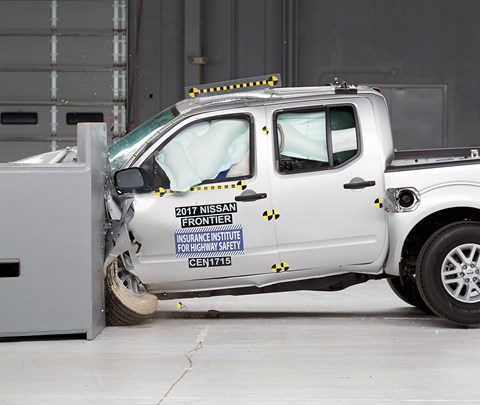
Action shot taken during the driver-side small overlap frontal crash test.
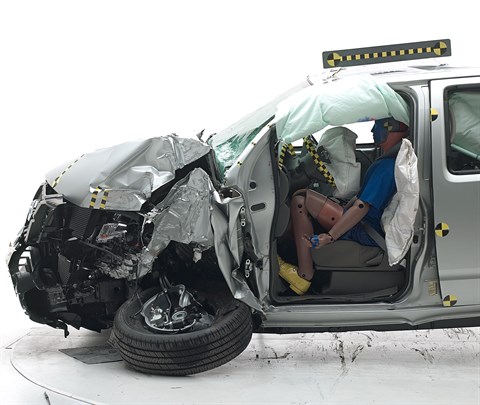
The dummy's position in relation to the door frame, steering wheel, and instrument panel after the crash test indicates that the driver’s survival space was not maintained well.
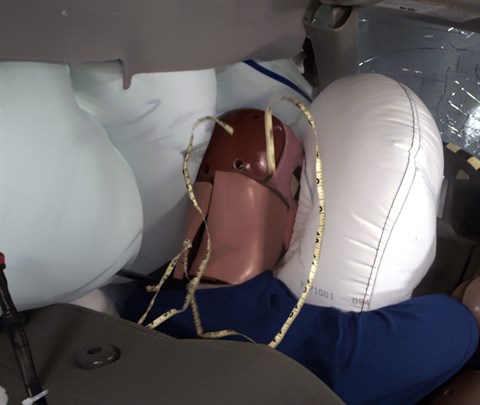
The frontal and side curtain airbags worked well together to keep the head from coming close to any stiff structure or outside objects that could cause injury.
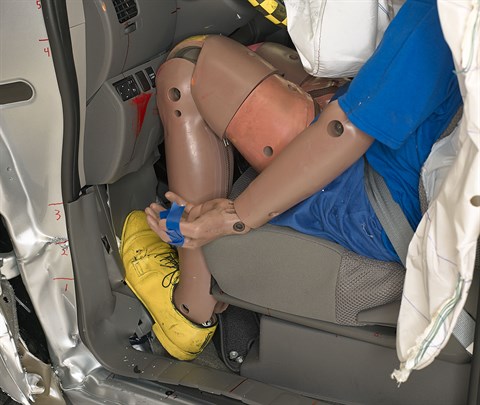
Extensive intrusion of the footwell and brake pedal (not visible in photo) contributed to a high risk of injuries to both lower legs and a significant risk to the left foot and right knee.
Small overlap front: passenger-side
Rating applies to 2017-21 models built after February 2017
Tested vehicle: 2018 Nissan Frontier S Crew Cab
The Nissan Frontier Crew Cab was redesigned for the 2005 model year. Beginning with 2013 models, design changes were made to the frontal airbags and seat belts. Beginning with 2017 models built after February 2017, the side curtain airbags were lengthened to improve occupant protection in small overlap frontal crashes. (Information about when a specific vehicle was manufactured is on the certification label typically affixed to the car on the driver door or adjacent B-pillar.)
| Evaluation criteria | Rating |
|---|---|
| Overall evaluation | |
| Structure and safety cage | |
| Passenger injury measures | |
| Head/neck | |
| Chest | |
| Hip/thigh | |
| Lower leg/foot | |
|
Passenger restraints and dummy kinematics
The dummy’s head contacted the frontal airbag but slid off the right side, leaving the head vulnerable to contact with forward structure. The side curtain airbag deployed and has sufficient forward coverage to protect the head from contact with side structure and outside objects. The side torso airbag also deployed. | |
| Driver injury measures | |
| Head/neck | |
| Chest | |
| Hip/thigh | |
| Lower leg/foot | |
| Driver restraints and dummy kinematics | |
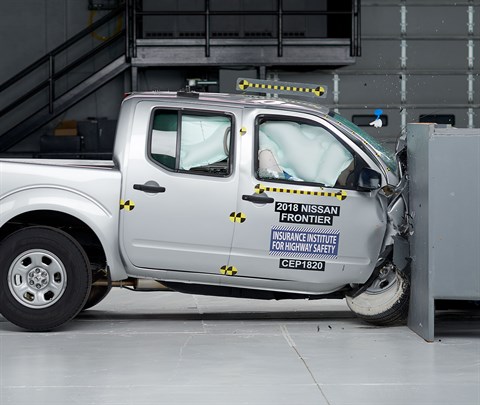
Action shot taken during the passenger-side small overlap frontal crash test.
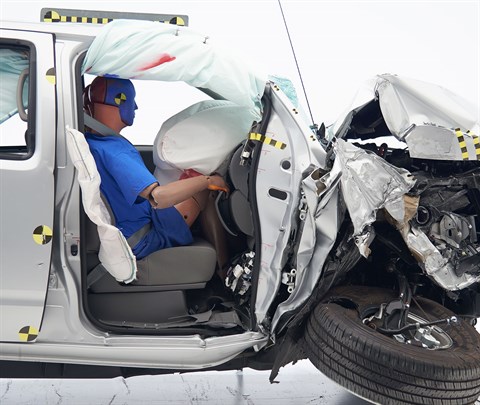
The dummy's position in relation to the door frame and dashboard after the crash test indicates that the passenger's survival space was not maintained well.

The dummy's head contacted the frontal airbag but then slid off the right side.

Extensive intrusion of the dashboard and toepan contributed to a likely risk of injury to the right lower leg and a significant risk to the right foot.
Moderate overlap front: original test
Rating applies to 2013-21 models
Tested vehicle: 2013 Nissan Frontier SV King Cab 4wd
The Nissan Frontier Crew Cab and King Cab were redesigned for the 2005 model year. Beginning with 2013 models, design changes were made to the frontal airbags and seat belts.
Moderate overlap frontal ratings are assigned by the Institute based on a test conducted by Nissan. (The vehicle tested by Nissan was designated as a 2012 model but included the airbag and seat belt changes of the 2013 models.) Because the vehicle structure did not change after 2005, structure ratings are based this test as well as two earlier tests of the Frontier, one a 2005 model and the other a 2008 model.
The moderate overlap frontal ratings apply to both the Crew Cab and King Cab models.
| Evaluation criteria | Rating |
|---|---|
| Overall evaluation | |
| Structure and safety cage | |
| Driver injury measures | |
| Head/neck | |
| Chest | |
| Leg/foot, left | |
| Leg/foot, right | |
| Driver restraints and dummy kinematics | |
Side: original test
Rating applies to 2015-21 models
Tested vehicle: 2015 Nissan Frontier SV Crew Cab 4wd with standard front and rear head curtain airbags and standard front seat-mounted torso airbags
The Nissan Frontier Crew Cab was redesigned for the 2005 model year. Beginning with 2012 models, design changes were made to the side curtain airbags to improve occupant protection in side impact crashes. Beginning with 2015 models, design changes were made to the side torso airbags and front door trim panels to further improve protection for front seat occupants.
Side ratings are assigned by the Institute based on a test conducted by Nissan. However, because there were no significant side structural changes since the 2005 model year, the structure rating of the most recent model is based on this Nissan test and an earlier test of a 2012 Frontier model plus two Institute tests of 2008 and 2010 models. Rear passenger dummy injury and head protection ratings are based on the two Nissan tests (2015 and 2012 models), because no changes were made affecting rear seat occupants since 2012.
| Evaluation criteria | Rating |
|---|---|
| Overall evaluation | |
| Structure and safety cage | |
| Driver injury measures | |
| Head/neck | |
| Torso | |
| Pelvis/leg | |
| Driver head protection | |
| Rear passenger injury measures | |
| Head/neck | |
| Torso | |
| Pelvis/leg | |
| Rear passenger head protection | |
Roof strength
Rating applies to 2016-21 models
Tested vehicle: 2017 Nissan Frontier SV Crew Cab
| Overall evaluation | |
|---|---|
| Curb weight | 4,224 lbs |
| Peak force | 20,487 lbs |
| Strength-to-weight ratio | 4.85 |
Head restraints & seats
Seat type: Manual cloth seats AHR
| Overall evaluation | |
|---|---|
| Dynamic rating | |
| Seat/head restraint geometry |
About the head restraint & seat test
Currently, IIHS tests apply only to front seats.
Headlights
Trim level(s)
- All trims
| Evaluation criteria | Rating |
|---|---|
| Low-beam headlight type | Halogen reflector |
| High-beam headlight type | Halogen reflector |
| Curve-adaptive? | No |
| High-beam assist? | No |
|
Overall rating | |
| Distance at which headlights provide at least 5 lux illumination: | |
Low beams
On the straightaway, visibility was inadequate on both sides of the road. On curves, visibility was inadequate in all 4 tests.
The low beams created some glare.
High beams
On the straightaway, visibility was inadequate on both sides of the road. On curves, visibility was inadequate in all 4 tests.
Child seat anchors
Rating applies to 2015-21 models
| Evaluation criteria | Rating |
|---|---|
| Overall evaluation | |
| Vehicle trim | SV Crew Cab |
| Seat type | cloth |
This vehicle has 2 rear seating positions with complete child seat attachment (LATCH) hardware.
It has 1 additional seating position with a tether anchor only.
| Evaluation criteria | Rating |
|---|---|
| Overall evaluation | |
| Vehicle trim | SV Crew Cab |
| Seat type | cloth |
| Rating icon | Rating |
|---|---|
| G | Good |
| A | Acceptable |
| M | Marginal |
| P | Poor |
| Seating positions that rely on borrowed lower anchors or have only a tether anchor available are not rated. | |
thether anchor symbol | Tether anchor |
lower anchor symbol | Lower anchors |
| Lower anchor(s) can be borrowed from adjacent positions(s) | |
| No hardware available |
Details by seating position
| Position | Rating |
|---|---|
| 1 | |
| Tether anchor | |
| hard-to-find location | |
| other hardware could be confused for anchor | |
| Lower anchors | |
| not too deep in seat | |
| not too much force needed to attach | |
| difficult to maneuver around anchors | |
| 2 | |
| Tether anchor | |
| hard-to-find location | |
| no other hardware could be confused for anchor | |
| Lower anchors | |
| none available | |
| 3 | |
| Tether anchor | |
| hard-to-find location | |
| other hardware could be confused for anchor | |
| Lower anchors | |
| not too deep in seat | |
| not too much force needed to attach | |
| difficult to maneuver around anchors |
